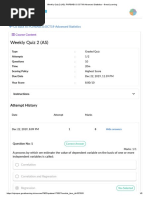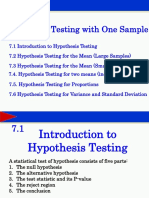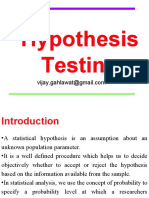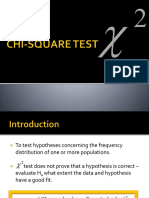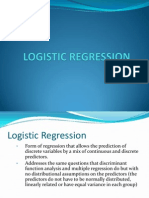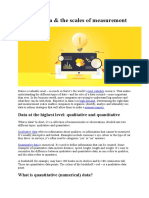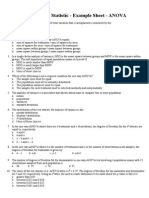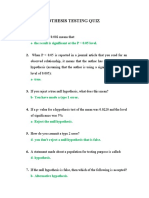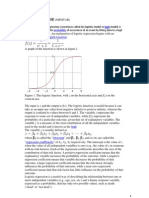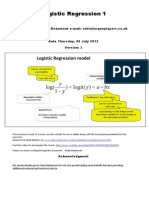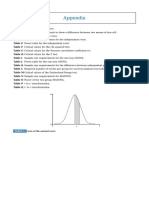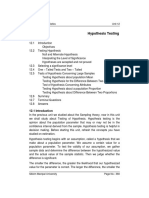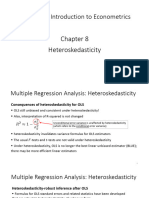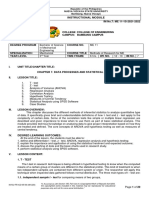Hypothesis Testing MBA
Hypothesis Testing MBA
Uploaded by
aksabhishek88Copyright:
Available Formats
Hypothesis Testing MBA
Hypothesis Testing MBA
Uploaded by
aksabhishek88Original Description:
Copyright
Available Formats
Share this document
Did you find this document useful?
Is this content inappropriate?
Copyright:
Available Formats
Hypothesis Testing MBA
Hypothesis Testing MBA
Uploaded by
aksabhishek88Copyright:
Available Formats
Hypothesis Testing
Hypothesis Testing
A statistical hypothesis is some statement about the
population, which may or may not be true. Under
Hypothesis Testing , we have to test the validity of this
statement on the basis of the evidence from a random
sample.
Null Hypothesis: if we want to test any statement
about the population, we setup null hypothesis which
says that the statement is true, e.g. if we want to find
out if the population mean has a specified value say 0,
then null hypothesis is set up as:
Alternative Hypothesis:
0 0
: = H
0 1
: = H
Procedure For Hypothesis Testing
Step I : setup the null Hypothesis e.g.
Step II : setup the Alternative Hypothesis e.g.
Step III: Decide level of significance e.g. = 5%
Step IV: Compute test statistic under the validity of
null hypothesis as
0 0
: = H
0 1
: = H
) 1 , 0 ( ~
) ( .
) (
N
x E S
x E x
Z
=
statistic any for V N S Variate Normal
a as defined be can Z x E where
) . . ( Standard
, ) ( =
Step V: Conclusion: We compare the computed value of Z in
step (iv) with the significant value Z
(tabulated value)
at given level of significance
if |Z| < Z
, then Z is not significant i.e. difference b/w
statistic and the difference is just due to sampling fluctuations
H
0
can not be rejected & Vice Versa.
Types of Error in Hypothesis Testing
Type I Error: Reject H
0
when it is true P (Type I Error)=
: Level of significance
1- = P (Rejecting H
0
when it is false)
Type II Error: Accept H
0
when it is false
P (Type II Error)=
1- = P (Accepting H
0
when it is true)
Critical Values Level of Significance ()
Two Tailed Test
Right Tailed Test
Left Tailed Test
1% 5% 10%
2.58
2.33
-2.33 -1.645
1.645
1.96 1.645
1.28
-1.28
Hypothesis Testing
Single Mean
Difference of Mean
Single Proportion
Difference of Proportion
Z Test Statistic for the Mean
Z Test Statistic for the Mean
of a Normal Population
of a Normal Population
Assumptions
Population is normally distributed
If not normal, requires large samples
z test statistic
n
x
x
z
x
o
o
=
Sampling Distribution of Mean
has a sampling distribution with mean
i.e. E( ) =
X
X
n
X
o
Z =
n
as
X E S and mean with on Distributi Normal f ollows X
o
2
) .( .
Acceptance and Rejection Region
1.96 1.96
Acceptance Region
P-value (Observed Significance Level)
P-value - Measure of the strength of evidence the
sample data provides against the null hypothesis:
) ( :
obs
z Z P p val P > =
Large Sample Test
Sample is large if n > 30
S.N.V to a statistic:
= n as N
t E S
t E t
Z ) 1 , 0 ( ~
) .( .
) (
(i) Testing the significance of mean ) (x
n
x
x E S
x E x
Z
/
) ( .
) (
2
o
=
=
Compare Z
0.05
= 1.96 with |Z|
Critical values of Z Level of Significance
Two - tailed
One - tailed
5% 10% 1%
1.96 1. 645 2.58
1. 645
Company dealing in readymade garmnets wants to
know consumers rating of their product.
One set of consumers selected in Delhi. Asked to rate
their brand on a scale of 5. Now market researcher
wants to know whether the consumers rating exceeds
4 or not.
Example
471 . 2
293 . 0
4 724 . 4
/
05 . 0
4 :
4 :
2
1
0
=
=
=
>
s
n
x
Z
H
H
o
o
z
0.05
(one- tailed)=1.645
|Z| > z
0.05
H
1
accepted
(ii) Test of significance for difference of Means
Whether the two population means are same or not?
2 1 1
2 1 0
:
:
=
=
H
H
) 1 , 0 ( ~
2
2
2
1
2
1
2 1
N
n n
x x
Z
o o
+
=
Sampling Distribution of Difference in Means
In large samples, the difference in two sample means is
approximately normally distributed:
|
|
.
|
\
|
+
2
2
2
1
2
1
2 1
2 1 , ~
n n
N Y Y
o o
Under the null hypothesis,
1
-
2
=0 and:
) 1 , 0 ( ~
2
2
2
1
2
1
2 1
N
n n
Y Y
Z
o o
+
=
o
1
2
and o
2
2
are unknown and estimated by s
1
2
and s
2
2
Example - Efficacy Test for New drug
Null hypothesis - New drug is no better than standard trt
Std New
H = :
0
Alternative hypothesis - New drug is better than standard trt
Std New A
H > :
Experimental (Sample) data:
Std New
Std New
Std New
n n
s s
y y
Example - Efficacy Test for New drug
Type I error - Concluding that the new drug is better than the
standard (H
A
) when in fact it is no better (H
0
). Ineffective drug is
deemed better.
Traditionally o = P(Type I error) = 0.05
Type II error - Failing to conclude that the new drug is better (H
A
)
when in fact it is. Effective drug is deemed to be no better.
Traditionally a clinically important difference (A) is assigned
and sample sizes chosen so that:
| = P(Type II error |
1
-
2
= A) s .20
Example:
In order to make a survey of the buying habits, two markets A
& B are chosen at two different parts of a city.
Market A Market B
40
250
400
1
1
1
=
=
=
s
x
n
55
220
400
2
2
2
=
=
=
s
x
n
i
x
Average weekly expenditure on food
Test at 1 % level of significance whether the average
weekly food expenditure of two populations of shoppers
is equal.
Example: Suppose company wants to know the rating
of their brand in two different cities is same or not.
Average rating on internal scale in Delhi is same as in
Bombay or different.
2 1 1
2 1 0
:
:
=
=
H
H
Z-test
(ii) Significance of Proportion:
n PQ
P p
p E S
p E p
Z
/
) ( .
) (
=
=
Compare Z
0.05
=1.96 with |Z|
Example:
(i) say, 65% of customers will like the new package design
(ii) 80% of the dealers will prefer the new pricing policy
65 . :
65 . :
1
0
=
=
p H
p H
80 . :
80 . :
1
0
=
=
p H
p H
Small Sample Tests
If the sample size n is small (less than 30), then the sampling
distribution of the statistics is far from normality. The normal
test cant be applied Exact Sample Tests are applied in such
cases.
Assumptions:
(i) The Parent population from which the sample is
drawn is normally distributed.
(ii) The sample is random and independent of each other.
T- test
1
2 2
~
/ 1 /
=
n
t
n S
x
n s
x
t
Confidence Limits for
1
=
n
s
t x
o
2 2
2 2
2
2
) 1 (
) ( ) 1 (
1
) (
s S
n
n
x x S n
n
x x
S
=
T-test for difference of Means
Whether the population means are equal?
| |
+
+
=
+
=
=
=
2
2
2
1
2 1
2
2
2 1
2
2 1
2 1 1
2 1 0
) ( ) (
2
1
~
)
1 1
(
:
:
2 1
x x x x
n n
s
t
n n
s
x x
t
H
H
n n
Example:
A group of 5 patients treated with medicine A weight 42,
39, 48, 60 and 41 Kgs. Second group of 7 patients treated
with Medicine B weigh 38, 42, 56, 64, 68, 69, 62 Kgs. Do
you agree with the claim that the medicine B increases
the weight significantly ?
t
0.05
at v=10 is 2.23
t
0.10
at v=10 is 1.81
Note:
Two samples in this test are independent
Difference of Means(Independent Samples)
Product rated on 7- point interval scale
S.No Delhi Bombay
1
2
3
4
5
6
7
8
9
10
11
12
13
14
15
2
3
3
4
5
4
4
5
3
4
5
4
3
3
4
3
4
5
6
5
5
5
4
3
3
5
6
6
6
5
(Separate set
of consumers)
H
0
: Mean ratings are same i.e. consumer rate the product in
two cities in same way.
rejected H t t
f d at t
t
H
0
2 1 1
2 1
| |
05 . 2 . . 28
75 . 2 | |
% 5
:
o
o
o
>
=
=
=
=
=
Significant Values Of t-Distribution
(Two-Tail Areas) P(|t| > t
) =
Rejection
region (/2)
Rejection
region (/2)
Acceptance
region (1-)
t=0 -t
()
t
()
d.f.
y
Probability ()
0.50 0.10 0.05 0.02 0.01 0.001
1
2
3
4
5
6
7
8
9
10
11
12
13
14
15
16
17
18
19
20
21
22
23
24
25
26
27
28
29
30
1.00
0.82
0.77
0.74
0.73
0.72
0.71
0.71
0.70
0.70
0.70
0.70
0.69
0.69
0.69
0.69
0.69
0.69
0.69
0.69
0.69
0.69
0.69
0.69
0.68
0.68
0.68
0.68
0.68
0.68
0.67
6.31
2.92
2.35
2.19
2.02
1.94
1.90
1.86
1.83
1.81
1.80
1.78
1.77
1.76
1.75
1.75
1.74
1.73
1.73
1.73
1.72
1.72
1.71
1.71
1.71
1.71
1.70
1.70
1.70
1.70
1.65
12.71
4.30
3.18
2.78
2.57
2.45
2.37
2.31
2.26
2.23
2.20
2.18
2.16
2.15
2.13
2.12
2.11
2.10
2.09
2.09
2.08
2.07
2.07
2.06
2.06
2.06
2.05
2.05
2.05
2.04
1.96
31.82
6.97
4.54
3.75
3.37
3.14
3.00
2.90
2.82
2.76
2.72
2.63
2.65
2.62
2.60
2.58
2.57
2.55
2.54
2.53
2.52
2.51
2.50
2.49
2.49
2.48
2.47
2.47
2.46
2.46
2.33
63.66
9.93
5.84
4.60
4.03
3.71
3.50
3.36
3.25
3.07
3.11
3.05
3.01
2.98
2.95
2.92
2.90
2.88
2.86
2.85
2.83
2.82
2.81
2.80
2.79
2.78
2.77
2.76
2.76
2.75
2.58
636.62
31.60
12.94
8.61
6.86
5.96
5.41
5.04
4.78
4.59
4.44
4.32
4.22
4.14
4.07
4.02
3.97
3.92
3.88
3.85
3.83
3.79
3.77
3.75
3.73
3.71
3.69
3.67
3.66
3.65
3.29
Paired t-test for difference of Mean
The two samples are dependent
1
~
:
:
=
=
=
n
y x
y x o
t
n
S
d
t
H
H
=
=
=
2 2
) (
1
1
d d
n
S
d
n
d
y x d
i
i i i
Ex. An IQ test was administered to 5 persons before and after they were
trained . The results sre given below
Candidates: I II III IV V
IQ B.T 110 120 123 132 125
IQ A.T 120 118 125 136 121
Test whether there is any change in IQ after training program
t
0.01
(4) = 4.6
Difference of Means (Dependent Samples)
Attitude measurement towards a brand before and after the ad campaign.
rating done on 10 point scale .
10: Highly disliked 1: Highly liked
SN Before Test After Test
1 3 5
2 4 6
3 2 6
4 5 7
5 3 8
6 4 4
7 5 6
8 3 7
9 4 5
10 2 4
11 2 6
12 4 7
13 1 4
14 3 6
15 6 8
16 3 4
17 2 5
18 3 6
o
o
o
t t
t
t
H
H
o
>
=
=
=
=
=
11 . 2
19 . 8
% 5
:
:
2 1 1
2 1
H
o
rejected hence Consumers rate the product differently in two cities.
Nonparametric Test (Applicable on non metric data i.e
nominal and ordinal data)
2
tests the statistical significance of the observed association in a cross
tabulation
2
) 1 )( 1 (
2
2
~
) (
(
=
c r
i
i i
E
E O
Find at (r-1)(c-1) d.f and compare with
2
05 . 0
Here Ei = (row total)(Column total) Grand total
Example
Gender and Internet usage
Internet
Usage
Male Female Row Total
Light(1) 5 10 15
Heavy(2) 10 5 15
Column 15 15 30
(responses are nominal)
O
i
E
i
(O
i
-E
i
) (Oi-Ei)
2
(Oi-Ei)
2
/E
i
5 15*15/30 = 7.5 |
10 15*15/30 = 7.5 |
11 15*15/30 = 7.5 |
5 15*15/30 = 7.5 |
(
i
i i
E
E O
2
) (
333 . 3
2
=
841 . 3 1
2
05 . 0
= at
Steps in testing the significance of statistics
Step I
H
o
: There is no association b/w Gender and Internet usage
Step II
H1 : Association b/w G & I is statistically significant
Step III
Level of significance = 0,05
Step IV
Under the validity of H
o
, test statistic would be
Step V Conclusion
<
2
2
) 1 )( 1 (
2
2
~
) (
(
=
c r
i
i i
E
E O
333 . 3
2
=
1
2
05 . 0
at
2
There is not enough evidence to reject the null hypothesis.
Therefore , the association between sex and internet usage is not
statistically significant.
2
Test for independence of attributes
In this case d.f = (r-1)(c-1)
Example:
Suppose that , in a public opinion survey answers to the questions :--
(a) Do you drink ?
(b) Are you in favor of local option on sale of liquor ?
were tabulated below
Can you infer that opinion on local option is dependent on whether or not
an individual drinks ?
Question (b) Question(a) Total
Yes No
Yes 56 31 87
No 18 6 24
Total 74 37 111
Examples on Square:
1. Survey of newspaper readership
H
o
Does income category influences the choice of paper
2. Ownership of Machines
H
o
Does income category influences the ownership
2
HIG MIG LIG Total
Times of India 35 72 172 279
Hindustan Times 21 62 164 247
Indian Express 14 26 84 124
Total 70 160 420 650
MIG HIG
Owners 23 13
Non owners 12 52
Hypothesis Testing on ranked data
Q: Rank the five brands of refrigerator shown on a scale of 1 to 5.
(1 = Best and 5 = Worst )
BRAND Rank
Whirlpool
Kelvinator
Godrej
Samsung
Videocon
Rank 1 2 3 4 5 Total
Wh 40 30 20 5 5 100
Kel 20 10 30 15 25 100
Godrj 15 20 10 15 40 100
Samsng 25 10 20 15 30 100
Vid 10 20 30 10 30 100
Can we say ranks given by the respondents are independent of the brand
or not
Significant Values Of CHI Square
Distribution (Right -Tail Areas)
P[x
2
> x
2
v
()] =
x
2
v
()
Rejection
region ()
X
2
Distribution
Curve
d.f.
(v)
Probability ()
99 95 .50 .10 .05 .02 .01
1
2
3
4
5
6
7
8
9
10
11
12
13
14
15
16
17
18
19
20
21
22
23
24
25
26
27
28
29
30
.000157
.0201
.115
.297
.554
.872
1.239
1.646
2.088
2.558
3.053
3.571
4.107
4.660
5.229
5.812
6.408
7.015
70.633
8.260
8.897
9.542
10.196
10.856
11.524
12.198
12.879
13.565
14.256
14.953
.000393
.103
.352
.711
1.145
1.635
2.167
2.733
3.325
3.940
4.575
5.226
5.892
6.571
7.261
7.962
8.672
9.390
10.117
10.851
11.591
12.338
13.091
13.848
14.611
15.379
16.151
16.928
17.708
18.493
.455
1.386
2.366
3.357
4.351
5.348
6.346
7.344
8.343
9.342
10.341
11.340
12.340
13.339
14.339
15.338
16.338
17.338
18.338
19.337
20.337
21.337
22.337
23.337
24.337
25.336
26.336
27.336
28.336
29.336
2.706
4.605
6.251
7.779
9.236
10.645
12.017
13.362
14.684
15.987
17.275
18.549
19.812
21.064
22.307
23.542
24.769
25.989
27.204
28.412
29.615
30.813
32.007
33.196
34.382
35.563
36.741
37.916
39.087
40.256
3.841
5.991
7.815
9.488
11.070
12.592
14.067
15.507
16.919
18.307
19.675
21.026
22.362
23.635
24.996
26.296
27.587
28.869
30.144
31.410
32.671
33.924
35.172
36.415
37.652
38.885
40.113
41.337
42.557
43.773
5.214
7.824
9.837
11.668
13.388
15.033
16.622
18.268
19.679
21.161
22.618
24.054
25.472
26.173
28.259
29.633
30.995
32.346
33.687
35.020
36.343
37.659
38.968
40.270
41.566
43.856
44.140
45.419
46.693
47.962
6.635
9.210
11.341
13.277
15.086
16.812
18.475
20.090
21.666
23.209
24.725
26.217
27.688
29.141
30.578
32.000
33.409
34.802
36.191
37.566
38.932
40.289
41.638
42.980
44.314
45.642
46.963
48.278
49.588
50.892
You might also like
- Weekly Quiz 2 (AS) - PGPBABI.O.OCT19 Advanced Statistics - Great Learning PDFDocument5 pagesWeekly Quiz 2 (AS) - PGPBABI.O.OCT19 Advanced Statistics - Great Learning PDFAnkitNo ratings yet
- Summary Table of Statistical Tests PDFDocument5 pagesSummary Table of Statistical Tests PDFLeonila Miranda100% (2)
- Regression AnalysisDocument13 pagesRegression AnalysissrikanthNo ratings yet
- Correlation NewDocument38 pagesCorrelation NewMEDISHETTY MANICHANDANA100% (1)
- Multiple RegressionDocument100 pagesMultiple RegressionNilton de SousaNo ratings yet
- Assignment #3 Hypothesis TestingDocument10 pagesAssignment #3 Hypothesis TestingJihen SmariNo ratings yet
- Multiple Choice Questions: Answer: DDocument41 pagesMultiple Choice Questions: Answer: DPavithra MaddipetlaNo ratings yet
- Confidence Interval EstimationDocument31 pagesConfidence Interval EstimationSaurabh Sharma100% (1)
- Simple and Multiple Regression AnalysisDocument48 pagesSimple and Multiple Regression AnalysisUmair Khan Niazi100% (1)
- Binary Logistic RegressionDocument11 pagesBinary Logistic RegressionOsama Riaz100% (1)
- Logistic RegressionDocument34 pagesLogistic RegressionMohamed Med100% (1)
- Hypothesis TestingDocument33 pagesHypothesis TestingRay Sang100% (1)
- Chapter-13: Analysis of Variance TechniquesDocument24 pagesChapter-13: Analysis of Variance TechniquespawanNo ratings yet
- Chapter 5,6 Regression AnalysisDocument44 pagesChapter 5,6 Regression AnalysisSumesh50% (2)
- Mann Whitney U TestDocument13 pagesMann Whitney U TestddualloNo ratings yet
- Lecture 8 ANOVADocument44 pagesLecture 8 ANOVARush-d Salaman100% (1)
- Factor AnalysisDocument36 pagesFactor AnalysisJayashree Chatterjee100% (2)
- Multiple Regression ProjectDocument10 pagesMultiple Regression Projectapi-27739305433% (3)
- Testing For Normality Using SPSS PDFDocument12 pagesTesting For Normality Using SPSS PDFΧρήστος Ντάνης100% (1)
- Unit 5 - Testing of Hypothesis - SLMDocument46 pagesUnit 5 - Testing of Hypothesis - SLMVineet SharmaNo ratings yet
- Hypothesis Test FullDocument41 pagesHypothesis Test Fullanindya_kunduNo ratings yet
- Regression AnalysisDocument41 pagesRegression AnalysisMuhammad ChaudhryNo ratings yet
- Hypothesis Testing Sept 2016Document54 pagesHypothesis Testing Sept 2016Somil GuptaNo ratings yet
- Ch7. Hypothesis TestingDocument86 pagesCh7. Hypothesis TestingKhongmuon Noi100% (1)
- Session-Correlation and RegressionDocument24 pagesSession-Correlation and RegressionDhivya SivananthamNo ratings yet
- Hypothesis TestingDocument58 pagesHypothesis Testingkartikharish100% (1)
- Multiple Regression Analysis and Model BuildingDocument57 pagesMultiple Regression Analysis and Model BuildingReader88% (8)
- Non Parametric TestsDocument6 pagesNon Parametric TestsRohit Vishal Kumar100% (9)
- Statistical Hypothesis TestDocument6 pagesStatistical Hypothesis TestIsh RomanNo ratings yet
- Hypothesis TestingDocument36 pagesHypothesis TestingPallavi Shettigar100% (1)
- Hypothesis Testing: By: Janice Galus CordovaDocument22 pagesHypothesis Testing: By: Janice Galus CordovaJaniceGalusCordova75% (4)
- Tests of HypothesisDocument16 pagesTests of HypothesisDilip YadavNo ratings yet
- Chi Square TestDocument43 pagesChi Square Testkak dah100% (2)
- L5 Logistic Regression (2011)Document55 pagesL5 Logistic Regression (2011)woihon100% (1)
- Exploratory Factor AnalysisDocument33 pagesExploratory Factor Analysismesut100% (1)
- Logistic Regression AnalysisDocument65 pagesLogistic Regression Analysismushtaque61100% (4)
- Assumptions of RegressionDocument16 pagesAssumptions of RegressionWaqar Ahmad100% (1)
- Chi SquareDocument22 pagesChi Squarehello everyone0% (1)
- Factor AnalysisDocument16 pagesFactor AnalysissairamNo ratings yet
- Non Parametric TestDocument16 pagesNon Parametric TestVIKAS DOGRA100% (1)
- Hypothesis TestingDocument21 pagesHypothesis TestingSidhartha MohapatraNo ratings yet
- Measures of Central TendencyDocument35 pagesMeasures of Central Tendencykartikharish100% (1)
- Chi Square TestDocument14 pagesChi Square TestHannah AguinaldoNo ratings yet
- Logistic RegressionDocument30 pagesLogistic RegressionSaba Khan100% (2)
- AnovaDocument49 pagesAnovabrianmore10100% (2)
- Types of Data & The Scales of Measurement: Data at The Highest Level: Qualitative and QuantitativeDocument7 pagesTypes of Data & The Scales of Measurement: Data at The Highest Level: Qualitative and QuantitativeSanthosh K SNo ratings yet
- Hierarchical Multiple Regression)Document90 pagesHierarchical Multiple Regression)Defiant TonesNo ratings yet
- Null Hypothesis, Statistics, Z-Test, SignificanceDocument4 pagesNull Hypothesis, Statistics, Z-Test, SignificanceSherwan R Shal0% (1)
- Logistic RegressionDocument37 pagesLogistic RegressionDhruv BansalNo ratings yet
- Example Sheet 4 ANOVADocument3 pagesExample Sheet 4 ANOVAmeochip21No ratings yet
- Hypothesis Testing QuizDocument2 pagesHypothesis Testing Quizabdullah hussinyNo ratings yet
- Introduction To Factor Analysis (Compatibility Mode) PDFDocument20 pagesIntroduction To Factor Analysis (Compatibility Mode) PDFchaitukmrNo ratings yet
- 01 Multivariate AnalysisDocument40 pages01 Multivariate Analysisxc123544100% (1)
- Logistic Regression Mini TabDocument20 pagesLogistic Regression Mini TabAnıl Toraman100% (3)
- Statistical Inference and Hypothesis TestingDocument34 pagesStatistical Inference and Hypothesis TestinghusainNo ratings yet
- Econ2330 Ch09Document65 pagesEcon2330 Ch09Wang AshleyNo ratings yet
- Logistic RegressionDocument33 pagesLogistic RegressionWaqar AhmadNo ratings yet
- Logistic RegressionDocument32 pagesLogistic RegressionJaya Verma100% (2)
- Hypothesis Testing (Lecture) PDFDocument50 pagesHypothesis Testing (Lecture) PDFSour Wolf50% (2)
- Simple Test of HypothesisDocument26 pagesSimple Test of HypothesisAlmina MajidNo ratings yet
- CH 7Document36 pagesCH 7Legese TusseNo ratings yet
- Katarina CointegrationDocument34 pagesKatarina CointegrationisaNo ratings yet
- Pengaruh Pelatihan Dan Pengembangan Sumber Daya Manusia Terhadap Kinerja Karyawan PT Dirgantara Indonesia (Persero) BandungDocument7 pagesPengaruh Pelatihan Dan Pengembangan Sumber Daya Manusia Terhadap Kinerja Karyawan PT Dirgantara Indonesia (Persero) BandungWilliam FelixNo ratings yet
- Latihan 1Document13 pagesLatihan 1natsirNo ratings yet
- Forecasting of Motorcycle Demand Using Calender Variations, Hybrid Calender Variations-ANN and Disagregation (Case Study in Jombang)Document8 pagesForecasting of Motorcycle Demand Using Calender Variations, Hybrid Calender Variations-ANN and Disagregation (Case Study in Jombang)Ratkum AlisusNo ratings yet
- Likelihoodist StatisticsDocument4 pagesLikelihoodist Statisticsdev414No ratings yet
- Research SalesDocument184 pagesResearch SalesMA RK RoblesNo ratings yet
- Problem 4, A Chemist WishesDocument4 pagesProblem 4, A Chemist WishesshasvinaNo ratings yet
- Statistics For Business and Economics: Bab 12Document34 pagesStatistics For Business and Economics: Bab 12baloNo ratings yet
- TSNotes 1Document29 pagesTSNotes 1YANGYUXINNo ratings yet
- Distribution Value TablesDocument13 pagesDistribution Value TablesdepetirNo ratings yet
- Final Lab Report-20bci7108Document22 pagesFinal Lab Report-20bci7108rupa sreeNo ratings yet
- Chapter 8 - Trendlines and Regression AnalysisDocument67 pagesChapter 8 - Trendlines and Regression AnalysisRachel BrenerNo ratings yet
- Stats Exam QnADocument9 pagesStats Exam QnApavansam6No ratings yet
- Statistical Inference - MA252Document2 pagesStatistical Inference - MA252Mohammad JamilNo ratings yet
- Analysis of Covariance-ANCOVA-with Two Groups PDFDocument41 pagesAnalysis of Covariance-ANCOVA-with Two Groups PDFAmar BhanguNo ratings yet
- Note #10 Correlation and RegressionDocument7 pagesNote #10 Correlation and Regressiontwanda bryanNo ratings yet
- Project Predictive ModelingDocument69 pagesProject Predictive Modelingyuktha50% (2)
- Business Research Methods: Introductory Lecture NotesDocument445 pagesBusiness Research Methods: Introductory Lecture NotesMiguel PereiraNo ratings yet
- Mca4020 SLM Unit 12Document18 pagesMca4020 SLM Unit 12AppTest PINo ratings yet
- Chapter 8Document20 pagesChapter 8amyakeNo ratings yet
- Statistics For ManagementDocument13 pagesStatistics For ManagementTridib RoyNo ratings yet
- Chapter 4 - Forecasting ProductionDocument58 pagesChapter 4 - Forecasting ProductionSerekeho LehlohonoloNo ratings yet
- Regression ExampleDocument7 pagesRegression ExamplerasnimNo ratings yet
- Chi Square Test Excel TemplateDocument6 pagesChi Square Test Excel TemplatetocharivaniNo ratings yet
- Hypothesis Testing: Two Types of Possible ErrorDocument33 pagesHypothesis Testing: Two Types of Possible ErrorProttoyNo ratings yet
- Statistics For Managers Using Microsoft Excel: 6 Global EditionDocument17 pagesStatistics For Managers Using Microsoft Excel: 6 Global EditionReza S CahyadiawanNo ratings yet
- ECON 322 ECONOMETRICS 11 - KabarakDocument6 pagesECON 322 ECONOMETRICS 11 - Kabarak11803098danNo ratings yet
- Ex HypothesistestDocument22 pagesEx HypothesistestYana CovarNo ratings yet
- Mor 7 Nvsu-Fr-Icd-05-00Document20 pagesMor 7 Nvsu-Fr-Icd-05-00Aliza PoyatosNo ratings yet
